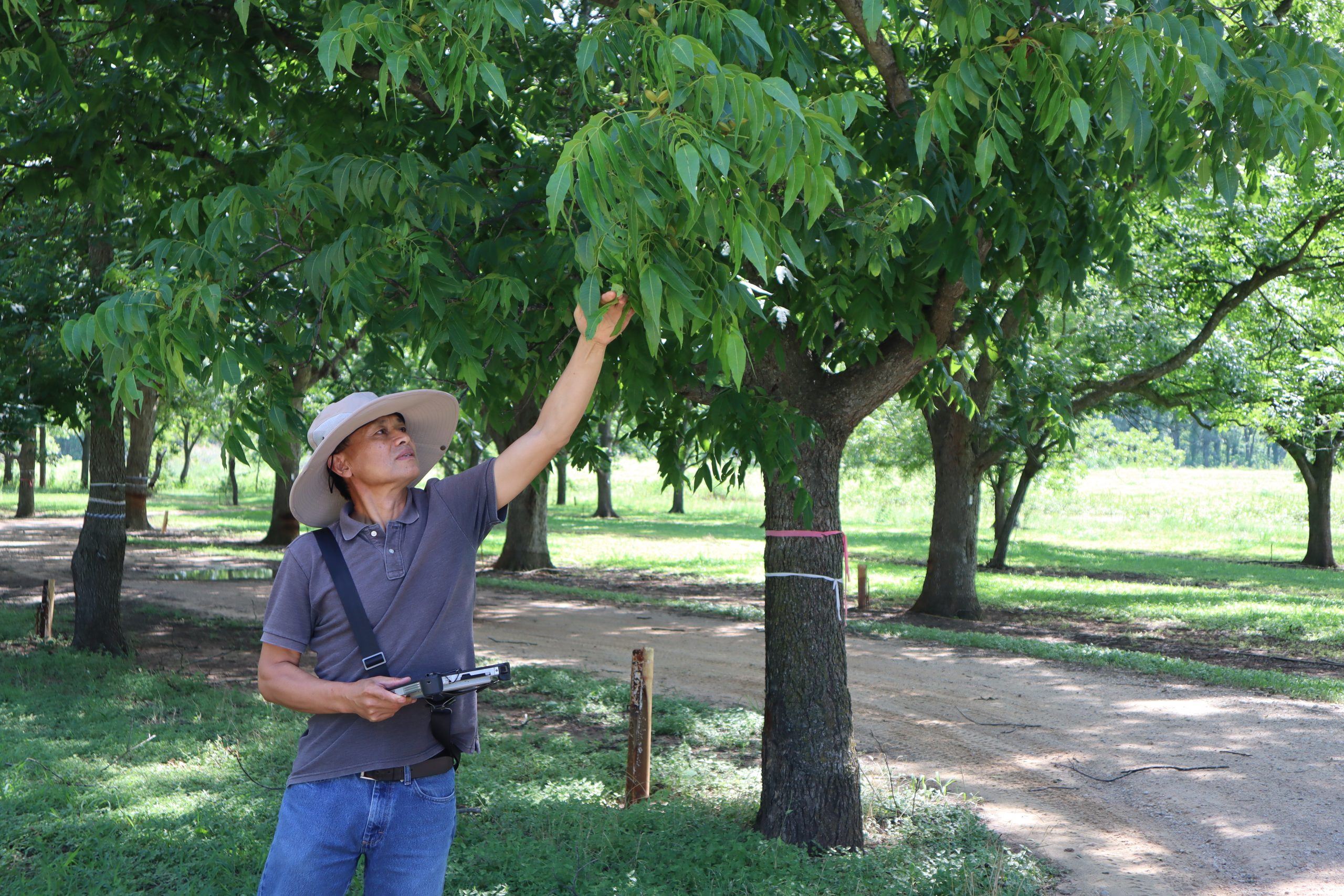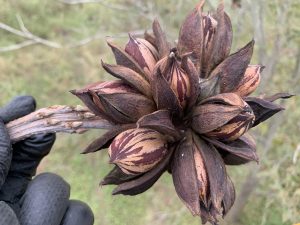Selecting the Perfect Pecan Tree

Dr. Xinwang Wang examining leaf scab on a 'Waco' tree at the USDA-ARS Pecan Breeding Station in Somerville, Texas. (Photo by Warren Chatwin, USDA ARS)
Nut yield has consistently remained the number one trait breeders rely on to make their selections. Nut yield includes the number of branches that bear nut clusters, the number of nuts per cluster, the number of nuts per pound, and the number of pounds harvested per tree. Optimally, there should be a high number of branches with clusters, and they should be evenly distributed across the entire canopy. Identifying the number of nuts per cluster is also critical. But how many nuts per cluster are adequate? In this case, less is more. An average of 3 nuts per cluster is ideal to ensure proper filling and maintain higher yields.
We see consumers paying top-dollar for large, mammoth kernels, but is bigger always better? Large nuts are certainly appealing; however, the tree must utilize more water and energy storage to fill those nuts. This is especially true for trees that exhibit a significant crop load and a greater number of nuts per cluster, such as ‘Pawnee’ and ‘Lakota.’ Producers mitigate these issues by thinning their crop mid-season, which increases labor and fuel costs. Our program is focused on evaluating traits related to crop load, yield, and the resulting quality to identify trees capable of producing larger nuts with a high percent kernel that minimizes undue stress on the tree.
High nut quality is another primary concern in the USDA Pecan Breeding Program. Nut quality is not defined by a single trait but by a group of traits deemed essential to the industry. Kernel appearance is also critically evaluated. Large kernels are often sought after, but the perfect nut must have other qualities that appeal to consumers. Fancy kernels, or those with a lighter color, are often preferred to darker kernels, and minimizing the presence of fuzzy or veiny kernels can ensure a more uniform presentation. The grooves on nuts are also important to evaluate. Narrow grooves can trap packing material, or excess pieces of shell, during the shelling process, which can cause kernels to taste bitter. Pecans naturally possess antioxidants and other nutrients that promote heart health. Characteristics like kernel nutrition, fat and oil content, and flavor can maximize pecans’ marketability to consumers. These ‘health’ qualities have not been evaluated historically but are traits we are interested in pursuing as our program grows.
Nut maturity is the third selection criterion and is determined by several factors. The number of days from bud break to shuck split determines how long the growing season will last for a given cultivar. Shortening the length of the growing season has been a focus of our breeding program in the last few decades, primarily by breeding cultivars that mature earlier. Most native pecans tend to be ready for harvest in mid-October to early November. Focused breeding efforts in our USDA program have developed cultivars like ‘Pawnee’ that mature in mid-to-late September. Earlier harvests allow for faster sales to holiday markets and drastically reduce the inputs and fuel required to maintain the crop. Our program continues to focus on developing cultivars that allow for an earlier harvest period while considering the impacts it can have on crop load.
Pecan scab is one of the most economically significant diseases of pecan and can lead to total yield losses in susceptible cultivars. The fungus that causes scab can infect leaves and nuts and dramatically impact nut quality. Fungicide treatments to prevent pecan scab are one of the costliest measures producers face from Central Texas to Georgia. Breeding pecan trees for resistance to scab has been a primary focus for pecan breeders at multiple institutions, including the USDA Pecan Breeding Program.
One of the greatest roadblocks when it comes to breeding plants for disease resistance is the rate at which a pathogenic organism can adapt to its host. Scientists refer to this as the ‘arms race.’ Cultivars that were previously considered to be resistant to scab may become more susceptible as the fungus evolves. Other emerging diseases that were once unconsidered are also becoming a priority for the USDA Pecan Breeding Program. For instance, Pecan Bacterial Leaf Scorch is now considered a significant problem for western producers. Scientists are looking for new ways to evaluate cultivars for susceptibility to the disease. There are currently no known resistant cultivars to Pecan Bacterial Leaf Scorch.
There have been more recent requests by producers fonur the USDA Pecan Breeding Program to consider other traits. For example, nutrient uptake and use efficiency is something that was investigated during the early years of pecan breeding but has taken a back seat over the last several decades. Identifying new cultivars that require fewer applications of nitrogen, zinc, or nickel is potentially one of the biggest cost-saving measures that can be offered to the industry. Salt and drought tolerance are major problems facing many producers in the western pecan-growing region. Early spring freezes have also caused devastating crop losses across many growing regions, demonstrating a need for cold hardiness evaluations. Another issue facing many producers is the outbreak of black pecan aphids, which can cause significant defoliation and reduction of photosynthesis. Not all problems are easily (or quickly) solved through plant breeding; some may be better addressed through orchard management methods. Still, the USDA Pecan Breeding Program is committed to identifying rootstock varieties and scion cultivars with improved adaptation. We have ongoing collaborations with other pecan research institutions actively investigating some of these issues to create better pecan trees for our stakeholders.
One of the major obstacles we face in plant breeding is that most of the traits described have previously needed to be phenotyped in the field. New methods, such as image analysis, can aid in the speed and efficiency of evaluating pecan traits and collecting new data that has been largely unexplored. The USDA Pecan Breeding Program is limited to two sites in Brownwood and Somerville, Texas. It is difficult to anticipate the performance of trees in areas in which they have not been evaluated, and traits like cold-hardiness are near-impossible to evaluate in Central Texas. For this purpose, our program is identifying partners to evaluate promising breeding lines across multiple areas of the Pecan Belt. Trees will be sent north, south, east, and west to better understand how potential new pecan cultivars will perform in each region.
As always, the USDA Pecan Breeding Program encourages feedback from producers. Our program is at a transition point where we are hiring new scientists, incorporating new technologies, and re-evaluating what traits need to be incorporated into our breeding process. Considering the changes in market demands and food standards, we have to make adjustments to our breeding strategies in order to provide ‘perfect’ new cultivars. While we haven’t had the time to discuss every trait we evaluate in pecan breeding, if there is a specific problem you feel we need to consider, we want to hear from you! Please get in touch with us by sending an email to warren.chatwin@usda.gov.


